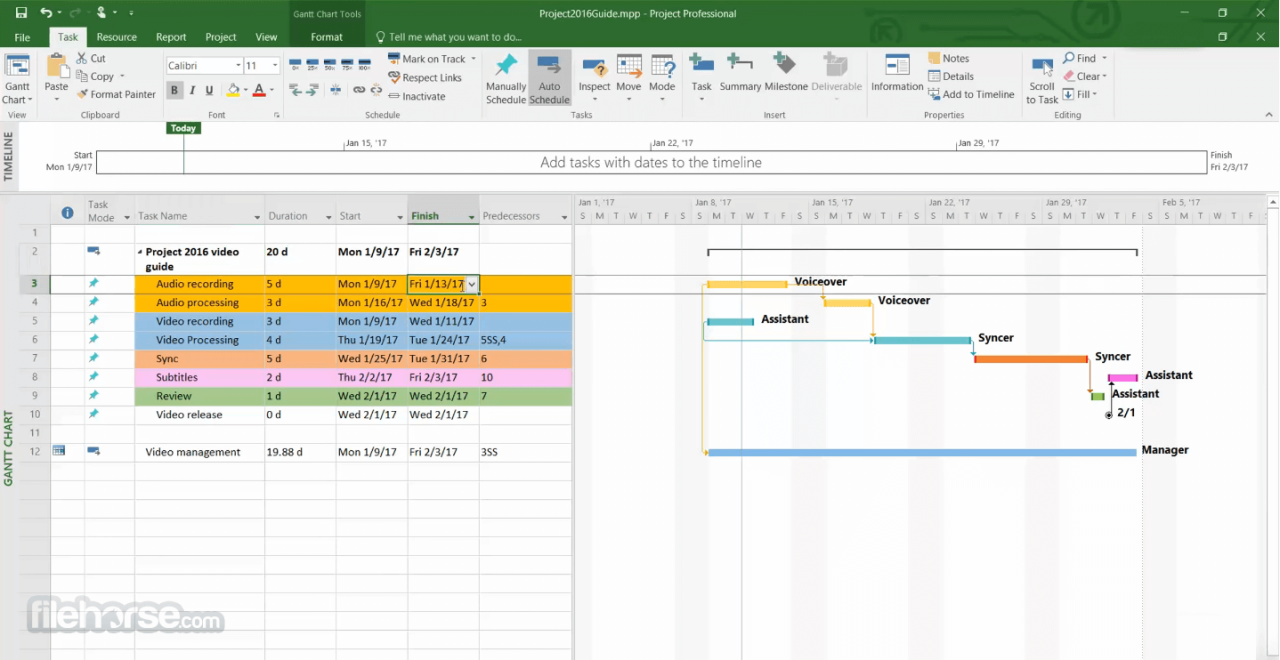Microsoft Project download sets the stage for this exploration, offering readers a glimpse into a powerful tool for project management. Whether you’re a seasoned professional or just starting out, Microsoft Project provides the features and functionality needed to streamline your projects, enhance collaboration, and achieve successful outcomes.
Table of Contents
This comprehensive guide will walk you through the process of downloading, installing, and using Microsoft Project, covering everything from basic setup to advanced project management techniques. We’ll delve into the key features, explore the different versions available, and discuss the benefits of incorporating this software into your workflow.
Tracking Project Progress: Microsoft Project Download
Staying on top of project progress is crucial for successful project management. Microsoft Project provides powerful tools to monitor your project’s health and identify potential issues early on.
Methods for Tracking Project Progress, Microsoft project download
Microsoft Project offers a variety of methods to track project progress, allowing you to choose the approach that best suits your project needs and preferences.
- Task Completion Status: This is the most basic method, where you manually update the percentage of completion for each task. You can visually see how much work has been done and what remains.
- Actual Work vs. Planned Work: By tracking the actual time spent on tasks, you can compare it to the planned time. This helps identify potential delays or inefficiencies and adjust your schedule accordingly.
- Progress Bars: Gantt charts prominently display progress bars for each task, offering a visual representation of completion status. This is a quick and easy way to understand the overall project progress at a glance.
- Custom Fields: Microsoft Project allows you to create custom fields to track specific metrics relevant to your project. This flexibility enables you to gather data that directly impacts your project’s success.
- Baseline Comparison: Baselines provide a snapshot of your original project plan. By comparing the baseline to the current progress, you can identify deviations and assess the impact on your project’s schedule and budget.
Creating and Using Reports
Reports are essential for analyzing project progress and communicating status updates to stakeholders.
- Standard Reports: Microsoft Project offers a variety of pre-built reports, such as task usage, resource usage, and project summary reports, providing valuable insights into project performance.
- Custom Reports: You can customize reports to display specific data relevant to your project. This allows you to tailor reports to the needs of your audience and ensure they receive the information they require.
- Visualizations: Reports can include charts, graphs, and other visualizations to enhance data presentation and make it easier to understand key trends and patterns.
Using Gantt Charts and Other Visualizations
Gantt charts are a cornerstone of project management, providing a visual representation of tasks, deadlines, and dependencies.
- Task Dependencies: Gantt charts visually depict task dependencies, showing how tasks relate to each other and highlighting potential bottlenecks or delays.
- Critical Path: The critical path represents the sequence of tasks that must be completed on time to meet the project deadline. Gantt charts clearly highlight the critical path, allowing you to focus on critical tasks.
- Resource Allocation: Gantt charts can be used to visualize resource allocation, ensuring you have the right resources assigned to the right tasks at the right time.
Integrating with Other Tools

Microsoft Project seamlessly integrates with various other software applications, enabling data sharing and collaborative workflows. This integration allows for enhanced project management capabilities and streamlined communication across teams.
Connecting Microsoft Project to Other Tools
Connecting Microsoft Project to other tools involves utilizing features like APIs, web services, and integrations offered by both Microsoft Project and the third-party application. These connections facilitate data exchange and synchronization between the platforms, ensuring consistency and real-time updates.
Examples of Integrations
Microsoft Project integrates with popular project management and communication tools, providing a unified platform for managing projects.
- Microsoft Teams: Microsoft Teams integration allows for seamless collaboration, file sharing, and real-time communication within projects. Users can access project plans, tasks, and updates directly within Teams, fostering efficient communication and collaboration.
- Microsoft Power BI: Power BI integration enables data visualization and reporting capabilities, allowing project managers to gain insights from project data. This integration allows for the creation of interactive dashboards, charts, and reports to track project progress, identify trends, and make data-driven decisions.
- Jira: Jira integration enables seamless integration with agile development workflows. Users can synchronize tasks, track progress, and manage issues between Microsoft Project and Jira, ensuring alignment between project plans and development activities.
- Slack: Slack integration allows for real-time project updates and notifications within the Slack platform. This integration keeps team members informed about project progress, deadlines, and task assignments, enhancing communication and collaboration.
- SharePoint: SharePoint integration allows for document sharing, collaboration, and project information storage. Users can access project files, documents, and resources directly within Microsoft Project, facilitating seamless collaboration and information management.
Closure
By understanding the fundamentals of Microsoft Project download, you’ll be equipped to effectively manage your projects, track progress, and collaborate with team members seamlessly. Whether you’re working on a small-scale initiative or a large-scale enterprise project, Microsoft Project empowers you to take control, optimize your resources, and deliver exceptional results.
Microsoft Project is a powerful tool for managing projects, especially those with complex timelines and resources. While it excels in project management, for visualizing and designing the physical aspects of your project, you might want to consider a cad software.
This combination of Microsoft Project and CAD can give you a comprehensive view of your project, from planning to execution and visualization.
